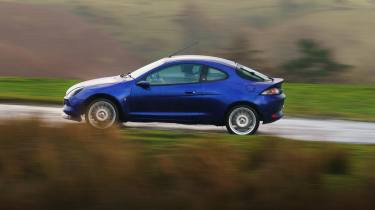Ford Racing Puma (1999 - 2001): review, history, prices and specs
An oft-underappreciated gem with a growing following, the Ford Racing Puma was arguably the marque's greatest ever front-driver
Launched in an era of outstanding front-wheel-drive machines such as the Renault Sport Clio 172 and Honda Integra Type R, the Ford Racing Puma had some tough competition. But despite its modest stats and a questionable price tag when new, those who drove one discovered a chassis that bristled with balance and fluidity, elevating this coupe of humble origins to a place among Ford’s best-ever front-drivers.
There’s no mistaking a Racing Puma for its ordinary counterpart, as the vast majority of its Ford Racing Blue bodywork is entirely bespoke. Its aluminium wheelarches are 100mm wider at the front and rear to accommodate sizable 70mm and 90mm increases in track respectively. Within these new arches are the Racing Puma’s trademark 17-inch multispoke Speedline alloys, two inches larger in diameter than the wheels on the standard car. The Alcon-designed, 295mm, four-piston front brake set-up was new too (the 253mm rear discs were from the Mk1 Focus), as was the Eibach/Sachs suspension. Inside, the door cards and Sparco seats were trimmed in blue Alcantara.
> Ford Fiesta ST (Mk8, 2017 - 2023) review and buying guide – a hot hatch that left on a high
The efforts made with the chassis and bodywork made the Racing Puma’s lack of power all the more puzzling at its reveal. Its 153bhp seemed modest even back in 1999, and was just 30bhp up on the most powerful standard Puma (which was 135kg lighter). Thankfully, the way in which it delivered that power made it not so much of an issue. The Yamaha-tuned 1.7-litre naturally aspirated four-cylinder gained a new inlet manifold, new camshafts and a less restrictive exhaust system, and was paired with shorter gearing to create a quick-revving powertrain that worked in perfect harmony with the uprated chassis.
What to look out for
That bulging bodywork is the Racing Puma’s real Achilles’ heel. Assembled by Tickford, its steel rear arches were essentially glued onto the existing wings, leaving a convenient gap for water to work its way into and rot the bodywork. It is something that can be rectified, but will cost in the region of £5000 depending on the severity. Keep an eye out for cracking on the unique fibreglass bumpers too, as genuine items are almost impossible to find.
More reviews
The Racing Puma is mechanically robust, however. Its engine is known to run well into six-figure mileage without an issue and if you do experience one, the ordinary 1.7-litre Puma engine can be converted to Racing spec without too much outlay. The gearbox is also a modified standard item and can be replaced or easily fixed should you suffer a rare failure. Check the Alcon front brake calipers have been well looked after, though – they’re race-spec items and require careful servicing every 3000 miles or so to avoid costly repairs. Also ensure the suspension is in tip-top condition, as original parts are no longer available to purchase.
What to pay
Prices once dropped to as low as £5000, but in 2024 you’ll struggle to find a Racing Puma for much less than £25,000. While all 500 examples were sold in the UK, there are thought to be far fewer left on the road today due to a combination of increasing values, numerous write-offs and the aforementioned corrosion issues. Nevertheless, find a good one and you’ll discover plenty to enjoy in this rare and rewarding Ford.
What we said
evo 016, Driven (February 2000), Richard Meaden
‘Just like the standard car, the Ford Racing Puma feels utterly together, the chassis always remaining smooth and unflustered, the engine razor-sharp and the power perfectly metered. The handling is deliciously fluid and malleable, allowing you so many options on the way in, through and out of the corner that you can always adjust the attitude of the car to suit the circumstances.
‘In the thick of a relentlessly testing road, I can’t think of another car that delivers such a feeling of oneness, feels so utterly planted or allows you to attack with such ferocity and unflinching confidence. It’s a pint-sized Porsche GT3, a bonsai RB5. If it had come from hot-hatch stock it would be hailed as the greatest GTi ever created.’
evo 140, Sublime Specials (February 2010), Henry Catchpole
‘With a hike of just 30bhp, this is no Focus RS approach to creating a fast Ford, but while its outright pace might not make the Racing Puma memorable, its handling certainly does. The nose reacts Elise-like to the slightest twitch of the wheel, darting around even in a straight line on the bumpy Sussex roads. In the corners the front feels so stiff and remains so flat that there’s almost zero progression in the wet.
‘It feels like the car is trying to pivot around the blue oval on its grille and grip becomes understeer becomes lift-off oversteer in rapid succession. Happily, with such instinctive steering it’s easily catchable, but it leaves you in no doubt that this Puma was designed with a circuit in mind.’
Ford Racing Puma specs
|
Engine
|
1679cc
|
|
Max power (bhp @ rpm)
|
153 @ 7000
|
|
Max torque (lb ft @ rpm)
|
119 @ 4500
|
|
Weight
|
1174kg
|
|
Power-to-weight
|
132bhp/ton
|
|
0-60mph
|
7.9sec
|
|
Top speed
|
126mph
|






